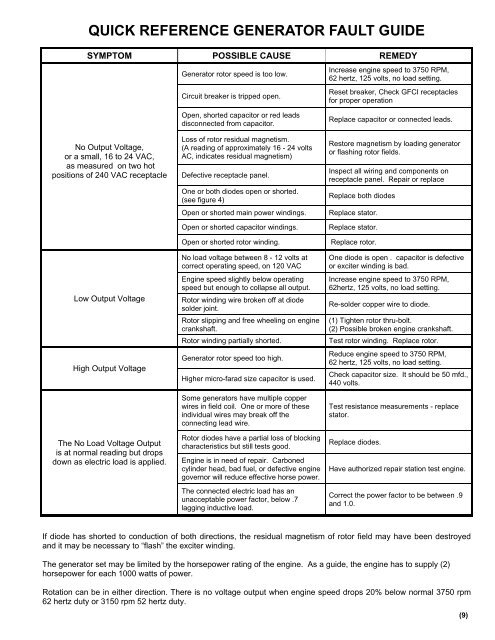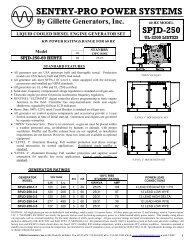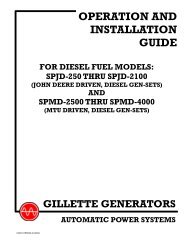PORTABLE Srvm3-20120822 - Gillette Generators
PORTABLE Srvm3-20120822 - Gillette Generators
PORTABLE Srvm3-20120822 - Gillette Generators
You also want an ePaper? Increase the reach of your titles
YUMPU automatically turns print PDFs into web optimized ePapers that Google loves.
QUICK REFERENCE GENERATOR FAULT GUIDE<br />
SYMPTOM POSSIBLE CAUSE REMEDY<br />
Generator rotor speed is too low.<br />
Circuit breaker is tripped open.<br />
Increase engine speed to 3750 RPM,<br />
62 hertz, 125 volts, no load setting.<br />
Reset breaker, Check GFCI receptacles<br />
for proper operation<br />
No Output Voltage,<br />
or a small, 16 to 24 VAC,<br />
as measured on two hot<br />
positions of 240 VAC receptacle<br />
Low Output Voltage<br />
High Output Voltage<br />
The No Load Voltage Output<br />
is at normal reading but drops<br />
down as electric load is applied.<br />
Open, shorted capacitor or red leads<br />
disconnected from capacitor.<br />
Loss of rotor residual magnetism.<br />
(A reading of approximately 16 - 24 volts<br />
AC, indicates residual magnetism)<br />
Defective receptacle panel.<br />
One or both diodes open or shorted.<br />
(see figure 4)<br />
Open or shorted main power windings.<br />
Open or shorted capacitor windings.<br />
Open or shorted rotor winding.<br />
No load voltage between 8 - 12 volts at<br />
correct operating speed, on 120 VAC<br />
Engine speed slightly below operating<br />
speed but enough to collapse all output.<br />
Rotor winding wire broken off at diode<br />
solder joint.<br />
Rotor slipping and free wheeling on engine<br />
crankshaft.<br />
Rotor winding partially shorted.<br />
Generator rotor speed too high.<br />
Higher micro-farad size capacitor is used.<br />
Some generators have multiple copper<br />
wires in field coil. One or more of these<br />
individual wires may break off the<br />
connecting lead wire.<br />
Rotor diodes have a partial loss of blocking<br />
characteristics but still tests good.<br />
Engine is in need of repair. Carboned<br />
cylinder head, bad fuel, or defective engine<br />
governor will reduce effective horse power.<br />
The connected electric load has an<br />
unacceptable power factor, below .7<br />
lagging inductive load.<br />
Replace capacitor or connected leads.<br />
Restore magnetism by loading generator<br />
or flashing rotor fields.<br />
Inspect all wiring and components on<br />
receptacle panel. Repair or replace<br />
Replace both diodes<br />
Replace stator.<br />
Replace stator.<br />
Replace rotor.<br />
One diode is open . capacitor is defective<br />
or exciter winding is bad.<br />
Increase engine speed to 3750 RPM,<br />
62hertz, 125 volts, no load setting.<br />
Re-solder copper wire to diode.<br />
(1) Tighten rotor thru-bolt.<br />
(2) Possible broken engine crankshaft.<br />
Test rotor winding. Replace rotor.<br />
Reduce engine speed to 3750 RPM,<br />
62 hertz, 125 volts, no load setting.<br />
Check capacitor size. It should be 50 mfd.,<br />
440 volts.<br />
Test resistance measurements - replace<br />
stator.<br />
Replace diodes.<br />
Have authorized repair station test engine.<br />
Correct the power factor to be between .9<br />
and 1.0.<br />
If diode has shorted to conduction of both directions, the residual magnetism of rotor field may have been destroyed<br />
and it may be necessary to “flash” the exciter winding.<br />
The generator set may be limited by the horsepower rating of the engine. As a guide, the engine has to supply (2)<br />
horsepower for each 1000 watts of power.<br />
Rotation can be in either direction. There is no voltage output when engine speed drops 20% below normal 3750 rpm<br />
62 hertz duty or 3150 rpm 52 hertz duty.<br />
(9)







